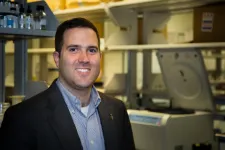(Press-News.org) Researchers at the Pritzker School of Molecular Engineering (PME) at the University of Chicago have designed a completely novel potential treatment for COVID-19: nanoparticles that capture SARS-CoV-2 viruses within the body and then use the body's own immune system to destroy it.
These "Nanotraps" attract the virus by mimicking the target cells the virus infects. When the virus binds to the Nanotraps, the traps then sequester the virus from other cells and target it for destruction by the immune system.
In theory, these Nanotraps could also be used on variants of the virus, leading to a potential new way to inhibit the virus going forward. Though the therapy remains in early stages of testing, the researchers envision it could be administered via a nasal spray as a treatment for COVID-19.
The results were published April 19 in the journal Matter.
"Since the pandemic began, our research team has been developing this new way to treat COVID-19," said Asst. Prof. Jun Huang, whose lab led the research. "We have done rigorous testing to prove that these Nanotraps work, and we are excited about their potential."
Designing the perfect trap
To design the Nanotrap, the research team - led by postdoctoral scholar Min Chen and graduate student Jill Rosenberg - looked into the mechanism SARS-CoV-2 uses to bind to cells: a spike-like protein on its surface that binds to a human cell's ACE2 receptor protein.
To create a trap that would bind to the virus in the same way, they designed nanoparticles with a high density of ACE2 proteins on their surface. Similarly, they designed other nanoparticles with neutralizing antibodies on their surfaces. (These antibodies are created inside the body when someone is infected and are designed to latch onto the coronavirus in various ways).
Both ACE2 proteins and neutralizing antibodies have been used in treatments for COVID-19, but by attaching them to nanoparticles, the researchers created an even more robust system for trapping and eliminating the virus.
Made of FDA-approved polymers and phospholipids, the nanoparticles are about 500 nanometers in diameter - much smaller than a cell. That means the Nanotraps can reach more areas inside the body and more effectively trap the virus.
The researchers tested the safety of the system in a mouse model and found no toxicity. They then tested the Nanotraps against a pseudovirus - a less potent model of a virus that doesn't replicate - in human lung cells in tissue culture plates and found that they completely blocked entry into the cells.
Once the pseudovirus bound itself to the nanoparticle - which in tests took about 10 minutes after injection - the nanoparticles used a molecule that calls the body's macrophages to engulf and degrade the Nanotrap. Macrophages will generally eat nanoparticles within the body, but the Nanotrap molecule speeds up the process. The nanoparticles were cleared and degraded within 48 hours.
The researchers also tested the nanoparticles with a pseudovirus in an ex vivo lung perfusion system - a pair of donated lungs that is kept alive with a ventilator - and found that they completely blocked infection in the lungs.
They also collaborated with researchers at Argonne National Laboratory to test the Nanotraps with a live virus (rather than a pseudovirus) in an in vitro system. They found that their system inhibited the virus 10 times better than neutralizing antibodies or soluble ACE2 alone.
A potential future treatment for COVID-19 and beyond
Next the researchers hope to further test the system, including more tests with a live virus and on the many virus variants.
"That's what is so powerful about this Nanotrap," Rosenberg said. "It's easily modulated. We can switch out different antibodies or proteins or target different immune cells, based on what we need with new variants."
The Nanotraps can be stored in a standard freezer and could ultimately be given via an intranasal spray, which would place them directly in the respiratory system and make them most effective.
The researchers say it is also possible to serve as a vaccine by optimizing the Nanotrap formulation, creating an ultimate therapeutic system for the virus.
"This is the starting point," Huang said. "We want to do something to help the world."
The research involved collaborators across departments, including chemistry, biology, and medicine.
INFORMATION:
Other authors on the paper include Xiaolei Cai, Andy Chao Hsuan Lee, Jiuyun Shi, Mindy Nguyen, Thirushan Wignakumar, Vikranth Mirle, Arianna Joy Edobor, John Fung, Jessica Scott Donington, Kumaran Shanmugarajah, Yiliang Lin, Eugene Chang, Glenn Randall, Pablo Penaloza-MacMaster, Bozhi Tian, and Maria Lucia Madariaga.
Citation: "Nanotraps for the containment and clearance of SARS-CoV-2," Chen and Rosenberg et. al, Matter, April 19, 2021, DOI:https://doi.org/10.1016/j.matt.2021.04.005
Funding: National Institutes of Health New Innovator award 1DP2AI144245, National Science Foundation Career award 1653782, and NIDDK RC2DK122394.
In a paper published in the journal Scientific Reports, researchers from Surrey investigated whether the daily consumption of a prebiotic food supplement could improve overall wellbeing in a group of 18 to 25 year-olds. The study found that those who received a daily dose of prebiotics improved mental wellbeing by reducing anxiety levels and had better gut health than the control group.
Researchers studied a group of 64 healthy female participants with no current or previous clinical diagnoses of anxiety. Participants received either a daily dose of the prebiotic galacto-oligosaccharides (GOS) or a placebo for 28 days.
All those involved in the trial completed surveys about their health experiences, including mood, anxiety and sleep quality and provided a stool sample ...
New studies from the Center for Advanced Bioenergy and Bioproducts Innovation (CABBI) shed more light on the economic and environmental costs of mandates in the Renewable Fuels Standard (RFS), a federal program to expand the nation's biofuels sector.
Researchers said the studies indicate the need to adopt more targeted policies that value the environmental and ecosystem benefits of perennial bioenergy crops over cheaper options -- and provide financial incentives for farmers to grow them.
The RFS was issued in 2005 and updated through the Energy Independence and Security Act of 2007 ...
MEMPHIS, Tenn. - For the first time in published literature, Le Bonheur Children's Hospital and University of Tennessee Health Science Center (UTHSC) researchers showed that a variety of white blood cells known as eosinophils modify the respiratory barrier during influenza A (IAV) infection, according to a recent paper in the journal Cells. This research could have implications in understanding SARS-CoV-2 (COVID-19) infection in asthmatic patients.
The Le Bonheur/UTHSC study found that eosinophils immunomodulate airway epithelial cells during IAV infection, helping to neutralize the virus and ...
The legend of the "kraken" has captivated humans for millennia. Stories of deep-sea squid dragging sailors and even entire ships to their doom can be found in everything from ancient Greek mythology to modern-day movie blockbusters. It is therefore ironic that the species that inspired these stories, the giant squid Architeuthis dux, is camera-shy. In fact, filming this species in the wild has proven an insurmountable challenge for countless scientists, explorers, and filmmakers. To date, only one scientist, Dr. Edith Widder of the Ocean Research & Conservation Association, has repeatedly caught a live giant squid on camera. In a new study, Dr. Widder and her colleagues have finally revealed the secrets behind their success. This study, which is free to access, also ...
An Academic Analytics Research Center (AARC) study published in the journal Scientometrics found that senior faculty (scholars who earned their terminal degree 30 or more years ago) research publication activity exceeded expectations based on age cohort population for book chapters and book publications, and senior scholars largely kept pace in terms of journal article publications. "Across all disciplines, senior faculty may be uniquely positioned to invest their time in a longer-term publication effort, shifting their research focus to the review and synthesis of ideas through the publication of books and chapters," said AARC Senior Researcher and Co-Author of the study, Bill Savage, Ph.D.
The study explored the publishing activity of 167,299 unique faculty members at American ...
Aromatics are major building blocks of polymers, or plastics, that turn up as everything from PET bottles for water to breathable, wrinkle-resistant polyester clothing. These petrochemicals comprise a specialized, value-added sector of the energy industry. The process for refining crude oil into useful aromatic streams for derivative use often involves the usage of a catalyst to facilitate chemical reactions. Among the various types of catalysts, many are zeolites - porous aluminosilicates - such as ZSM-5, a unique synthetic zeolite prolifically used in the upgrading of chemicals in alkylation and isomerization. Petrochemicals producers are constantly looking to minimize overhead costs to weather the volatility in commodity markets and provide a competitive end product ...
NEWPORT NEWS - Nuclear physicists have made a new, highly accurate measurement of the thickness of the neutron "skin" that encompasses the lead nucleus in experiments conducted at the U.S. Department of Energy's Thomas Jefferson National Accelerator Facility and just published in Physical Review Letters. The result, which revealed a neutron skin thickness of .28 millionths of a nanometer, has important implications for the structure and size of neutron stars.
The protons and neutrons that form the nucleus at the heart of every atom in the universe help determine each atom's identity and properties. Nuclear physicists are studying different nuclei to learn more about how these protons and neutrons act inside the nucleus. The Lead Radius Experiment collaboration, called PREx (after ...
WASHINGTON, April 27, 2021 -- A wide variety of portable and wearable electronics have become a large part of our daily lives, so a group of Stanford University researchers wondered if these could be powered by harvesting electricity from the waste heat that exists all around us.
Further inspiration came from a desire to ultimately fabricate energy converting devices from the same materials as the active devices themselves, so they can blend in as an integral part of the total system. Today, many biomedical nanodevices' power supplies come from several types of batteries that must be separated from the active portion of the systems, which is not ...
WASHINGTON, April 27, 2021 -- The AstraZeneca COVID-19 vaccine is suspected of being linked to a small number of deep vein thrombosis (DVT) cases, which recently emerged within Europe as millions of people received vaccinations. This led several countries to suspend AstraZeneca injections and investigate the causal links to DVT.
Researchers within Europe teamed up to explore a hypothesis that pausing AstraZeneca vaccinations, even for a short duration, could cause additional deaths from the faster spread of COVID-19 within a population of susceptible ...
What The Study Did: Researchers examined whether younger age at onset of type 2 diabetes was associated with an increased risk of subsequent dementia.
Authors: Archana Singh-Manoux, Ph.D., of the Université de Paris, is the corresponding author.
To access the embargoed study: Visit our For The Media website at this link https://media.jamanetwork.com/
(doi:10.1001/jama.2021.4001)
Editor's Note: The article includes conflict of interest and funding/support disclosures. Please see the article for additional information, including other authors, author contributions and affiliations, ...





